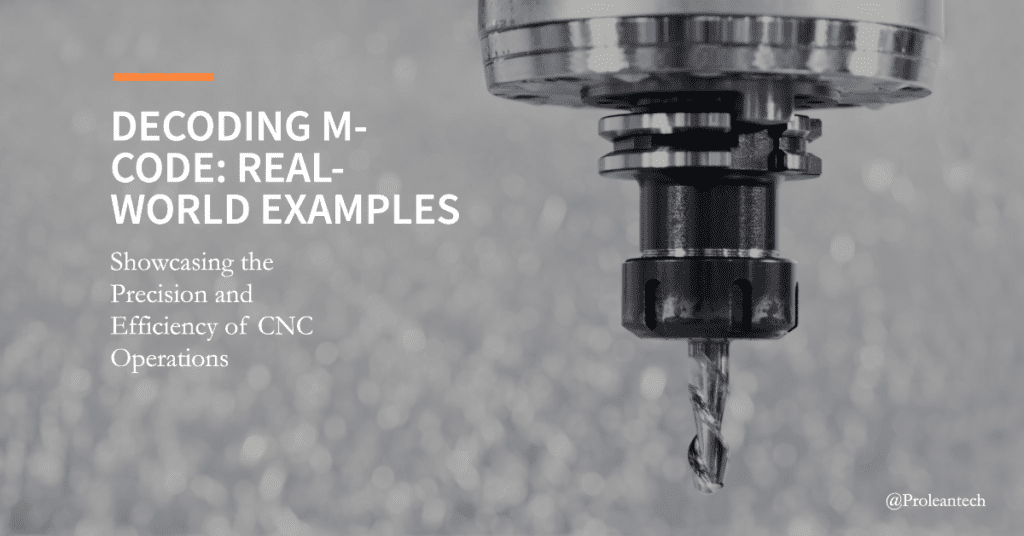
As technology continues to evolve and automation becomes more prevalent in industries, Computer Numerical Control (CNC) machining has emerged as an essential process for creating precise and complex parts. The heart of this process is CNC programming, a key component of which is M-Code – the command language that instructs the machine on auxiliary functions like turning on the coolant or changing the tool.
In this comprehensive guide, we’ll decode M-Code and delve into real-world examples of different CNC operations to equip you with the insights you need.
The Mechanics of M-Code: Syntax and Structure
Just as every language has its syntax and structure, so too does M-Code. Understanding these elements will not only facilitate the writing and reading of M-Code but also enhance the precision and efficiency of CNC operations.
1. The Structure of M-Code
Typically, an M-code command consists of the letter ‘M’, followed by a number. The number indicates the specific function to be performed by the machine. The table below summarizes a few commonly used M-codes and their functions:
| M-Code | Function |
|---|---|
| M00 | Program Stop |
| M01 | Optional Program Stop |
| M02 | End of Program |
| M03 | Start Spindle Clockwise |
| M04 | Start Spindle Counter-clockwise |
| M05 | Stop Spindle |
2. M-Code Syntax
When writing M-Code, it’s critical to follow the correct syntax, which generally involves placing the M-code in a block or line with other necessary information such as tool calls or feed rates. The precise syntax can vary depending on the machine and controller. Typically, a command line in a CNC program could look something like this:
- N10 T1 M06 (Tool change to Tool 1)
- N20 M03 S1200 (Start spindle clockwise at 1200 RPM)
- N30 G00 X10 Y-20 (Rapid movement to position X10 Y-20)
Understanding M-Code’s syntax and structure is the key to writing effective and efficient CNC programs, enabling machines to perform the correct function at the right time.
M-Code at Work: Examples of Basic CNC Operations
M-Code plays an integral role in enabling basic CNC operations, acting as the conductor that synchronizes the entire machining process. Let’s explore some of the most common CNC operations governed by M-Code.
1. Tool Change Operations
Tool change operations are a fundamental part of CNC machining, ensuring that the right tool is in the correct position at the appropriate time.
Example M-Code for a Tool Change Operation:
javaCopy code
N10 T1 M06 (Tool change to Tool 1)
N20 M03 S1200 (Start spindle clockwise at 1200 RPM)
Here, T1 calls for tool number 1, M06 initiates the tool change, M03 starts the spindle in a clockwise direction, and S1200 sets the spindle speed at 1200 RPM.
2. Coolant Control Operations
Coolant control is crucial in CNC machining to prevent tool wear and tear due to overheating. M-Code controls the coolant flow during the operation.
Example M-Code for a Coolant Control Operation:
vbnetCopy code
N10 M08 (Turn on the coolant)
N20 G01 X10 Y20 F200 (Linear move while coolant is on)
N30 M09 (Turn off the coolant)
In this example, M08 turns on the coolant, G01, X10, Y20, and F200 initiate a linear move, and M09 turns off the coolant after the operation.
A Deeper Dive: M-Code for Complex CNC Operations
Now that we’ve examined the role of M-Code in basic CNC operations let’s delve into more complex processes.
1. Pallet Change Operations
In more complex and advanced CNC machines like horizontal machining centers, pallet changes are a common feature. Pallet change operations allow for the machining of a part on one pallet while another part is being loaded onto a second pallet, thereby significantly reducing non-cutting time.
Example M-Code for a Pallet Change Operation:
bashCopy code
N10 M60 (Pallet change command)
In this example, M60 is the M-Code command that initiates the pallet change operation.
2. Activation of Probing Cycles
Modern CNC machines are equipped with probing systems for precise measurement and verification of part dimensions. Probing cycles can be initiated using specific M-Codes.
Example M-Code for Activation of a Probing Cycle:
sqlCopy code
N10 G65 P9832 A1.0 B2.0 D0.5 (Calls a probing cycle with parameters)
In this example, G65 calls a macro, P9832 specifies the type of probing cycle, and A, B, D are specific parameters for the probing operation (values are hypothetical and may differ depending on the CNC machine and controller).
Try Prolean Now!
Code is King: M-Code for CNC Lathe Operations
CNC lathes are powerful machines capable of creating complex parts in a single setup. Utilizing M-Code commands, lathes can perform various operations from simple to intricate. Let’s explore how M-Code guides the operations of CNC lathes.
1. Spindle Direction and Speed
M-Code sets the spindle direction and speed, crucial for maintaining dimensional accuracy and part finish.
Example M-Code for Spindle Direction and Speed:
javaCopy code
N10 M03 S5000 (Start spindle clockwise at 5000 RPM)
Here, M03 initiates the spindle to rotate clockwise, and S5000 sets the spindle speed at 5000 RPM.
2. Turret Operations
M-Code also controls turret operations, directing the placement and movement of tools for effective machining.
Example M-Code for a Turret Operation:
javaCopy code
N10 T0202 (Tool selection)
N20 M08 (Coolant on)
N30 M04 S1200 (Start spindle counter-clockwise at 1200 RPM)
T0202 specifies tool number 2, M08 turns on the coolant, and M04 S1200 starts the spindle in a counter-clockwise direction at 1200 RPM.
Mastering M-Code: A Skill for the Future
M-Code programming, while complex, is a valuable skill for machinists and programmers working with CNC machines. Mastery of M-Code allows for greater control, efficiency, and precision in CNC machining, making it an essential component of modern manufacturing.
Learning M-Code might seem daunting, but various resources, including programming manuals, online tutorials, and community forums, can aid in mastering this versatile language.
Benefits of M-Code Mastery
- Greater control over machine functions
- Enhanced capability to solve machining problems
- Increased efficiency in programming
- Expanded career opportunities
M-Code mastery isn’t just a way to enhance productivity—it’s a career booster, opening doors to more opportunities in the rapidly evolving field of CNC machining.
Prolean’s CNC Machining Services: Putting M-Code to Work
Prolean provides premium CNC machining services that meet strict quality standards, using M-Code to deliver precise parts. Our expertise in M-Code enables us to craft everything from simple components to complex designs with the utmost accuracy.
Our skilled programmers and machinists at Prolean are experts in M-Code, enabling us to maximize the potential of our advanced CNC machines. We provide high-quality precision parts with shorter lead times thanks to efficient programming. In addition, our programmers and machinists offer expert technical support for our clients.
Read more: CNC G Code: Definition, Example, and Code List
Conclusion
M-Code stands as an integral part of CNC programming, playing a critical role in directing machine functions and operations. From spindle control to coolant activation, from basic operations to complex machining processes, M-Code commands allow CNC machines to produce high-quality, precision parts consistently. As CNC technology continues to evolve, so does the importance and complexity of M-Code, making it a crucial skill for CNC machinists and programmers.
Whether you’re a seasoned professional, a beginner eager to delve into CNC programming, or a client seeking premium CNC machining services, understanding M-Code and its application can lead to increased productivity, improved part quality, and expanded opportunities. With Prolean’s CNC machining services, you can leverage our team’s M-Code expertise, ensuring every part produced meets your specific requirements.
FAQs
1. What is M-Code in CNC programming?
M-Code, or Miscellaneous Code, is a programming language used in CNC (Computer Numerical Control) machining to control various machine functions such as spindle speed and direction, coolant activation, and automatic tool changes.
2. What are some examples of M-Code commands?
Examples of M-Code commands include M03 (start spindle clockwise), M04 (start spindle counter-clockwise), M08 (coolant on), and M06 (automatic tool change). The specific functions controlled by M-Code can vary between different machine types and manufacturers.
3. How is M-Code different from G-Code in CNC programming?
While both are integral to CNC programming, G-Code primarily controls the motion of the machine tool, directing it to move in specific patterns or paths to cut or shape the material. On the other hand, M-Code controls specific machine functions such as activating the coolant or changing the tool.
4. Why is M-Code important in CNC machining?
M-Code is critical in CNC machining as it controls a variety of machine functions, enabling CNC machines to operate more autonomously. This improves efficiency, enhances precision, and reduces the likelihood of human error in the machining process.
5. How can I learn M-Code for CNC programming?
You can learn M-Code through various resources, including CNC programming manuals, online tutorials and courses, and community forums. Hands-on practice with a CNC machine can also be highly beneficial in mastering M-Code.




0 Comments